|
 |
RSS Feed  |
a playground of art, photos, videos, writing, music, life |
|
|

You are here
|

Creativity!
|

Get it!
|

I like it!
|

Fun stuff!
|

About me...
|
| |
|
|
|
|
Random Quote
The demonic paradox of writing: when you put something down that happened, people often don't believe it; whereas you can make up anything, and people assume it must have happened to you.
-- Andrew Holleran
|
|
|
|
|
|
Blog Posts for "drawing"
Page Through Blog: Home Page
Blog Archive by Month | Blog Archive by Story or Tag | Search Blog and Comments
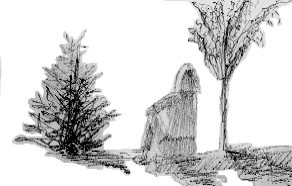 The boys and I went to a park today. Twice. The first time, Jacob had his old three-wheeling bike. Time for an upgrade - so we went to target and bought a two-wheeler. He'll be my last child to learn bicycling from me. Sigh... But when we went to the park, I took my sketchbook with me. A woman and her family were at the playground, and I did a fast rough sketch of her and the two trees that bookended her. I've come to believe that sketching is vital to my art. I need to practice, every day if possible. Earlier in the day, Cub and Nick and I went to Barnes & Nobles and I bought The Ultimate Book of Sketching. It's out of print, but B & N had four copies of it. It's a decent book, not so much on method, but for all of the examples the artists display. I've finished Richard Schmid's book on painting. Truly great book. I've tried my hand at painting and I've never had any formal training, so I've been reading voraciously to give me as much of the essence of it as I can muster on my own. Major influences so far would be Schmid, a watercolorist named David Becker, and Betty Edwards, who wrote Drawing on the Right Side of the Brain and her book on color. The good thing about the three of them is how much they disagree with each other. Becker's watercolors are effortless. He's what I would term a natural artist. Obviously, his "natural" ability is well-honed and practiced. He's a huge advicate of sketching and believes deeply in using initial sketches as a blueprint for composition and values (depth of darkness/brightness). He's unafraid to change a picture to get a better composition. He'll add people, change buildings, and completely ignore the picture's original colors to arrive at what he feels is the best and most interesting painting. Then there's Schmid, whose method is Alla Prima, or paint what you see in one sitting. He doesn't change colors. He paints it as it is, and he's quite ardent about that. Schmid's theory about color is to find a pallete that is true and then learn to blend the colors. He has a fantastic color chart near the end of the book that show how the colors of his pallette blend with each other, and he insists that everyone do this. I see wisdom in this and I'll be doing that myself in the next week or two. He goes into some depth about form (the shape of objects), value (the shading of objects), colors, and edges (the way in which colors and forms meet each other in a painting). Schmid's compositions are fairly straightforward - the subject of the painting is generally at the center and not surrounded by much else. He emphasizes the skill of drawing, like Becker. But he couldn't disagree more with Becker and Edwards about color. Becker and Edwards talk about color harmony. Becker's favorite three colors are purple, green, and yellow-orange; you see them prominently in just about every painting he does. Edwards spends a great deal of time in her book on color discussing how we naturally see harmony in certain colors. Schmid says that's all bullshit. He believes that lighting forces everything into a harmony of sorts. For example, moonlight will blend everything into a pleasant harmony under its spectrum. Sunlight, same thing. I like both perspectives on the subject. I'm too new at this to really have an opinion yet, but again, I'm busy fact-gathering to be as effective as I can be. Where Schmid really differs with the other two is on the topic of edges, and you can really see this in his paintings as well. I've browsed a lot of art books in trying to find ones that would help me understand better and enhance my work to bring out best what it is that I can do. Schmid's comprehensive treatment of edges is unique. Even he says as much in his book. Becker goes into edges a little in one book that I have, but I think watercolors are meant to blend more so that oil can. So are edges in watercolor not as important? I don't know. I do know that Schmid's work is amazing for what it achieves. The idea that he does his paintings, in oil, in a day knocks my socks off. So I've been thinking about all of this. My version of art training... and now my book on sketching to browse and keep me motivated. 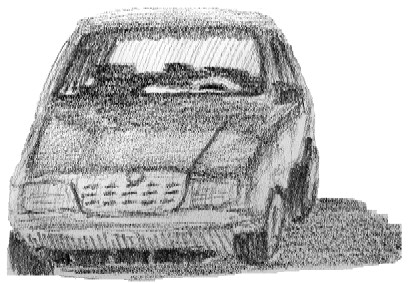 I have noticed that drawing from life is much harder than drawing from a photo. The photo comes with measurable sides and it's easier to get a sense of the shapes. Real life is much more difficult. Here again, this is Schmid's forte. His subjects sit in front of him, whether a landscape or a person. That's brave, in my opinion. So I'm convinced that I need to skecth from real life more often. The preceding sketch is of a car in a parking lot near where I live. Did I capture it? I don't know - I don't think it really matters. It's like a friend of mine likes to say, it's not success or failure that defines us but the journey. Now it's time to make dinner on this gorgeous day :) |
|
|
 | Drawing: Examples of the Grid |  |
The other day, I mentioned a gridded approach to drawing that helps to ensure accuracy and provides a method that just about anyone can follow. If you're getting started and you don't think you can draw, a grid can make it easy. And even if you're not getting started, you're in good company if you use such a system, as I'll show here. 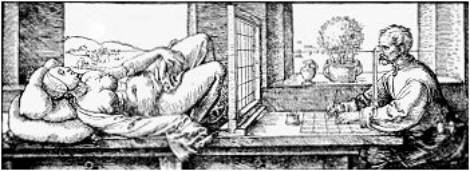 This was done by Albrecht Durer, and it's called "Draughtsman making a perspective Drawing of a Woman." He shows a wireframe window through which he views the subject of the drawing. The grid allows him to get the proportions correct as he draws the outline of the figure. This was done in 1525. A college math major did a paper that linked math to art. They said this: Alberti is known for introducing the approach of using drafting lines to create grids to guide the creation of life-like perspective and proportion. Leonardo Da Vinci worked on an instrument he called a "trellis work" that assisted artists in placing subjects realistically in conjunction with each other and relative perspective. In Germany, an artist named Albrecht Durer, worked with a method of transferring small drawings accurately to larger sizes using his grid system. Grids are still in use. Here's a wonderful example: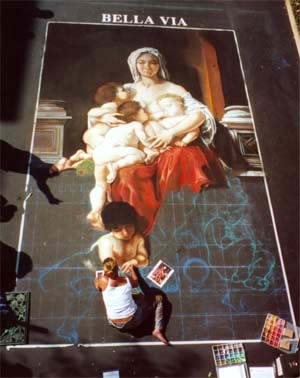 You can clearly see the chalked grid in the unfinished part of the street painter's work. Notice in particular the outline of the child curled up on the lower right. Let's take a closer look. 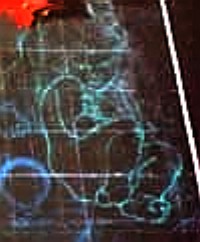 Now just look at the individual squares. I'll enhance it to help with that. 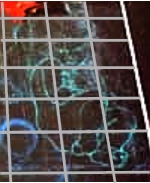 Broken down to the square and early chalk outline, this beautiful work of art doesn't seem so impossible to do. If you can use such a system to get the proportions correct, and if you can select colors, then you can most likely paint. I hope this thread on drawing helps to spark some possibilities for those who would hesitate to try their hand at art. It's just a matter of knowing the right steps to getting there. |
|
|
Drawing with a pencil is much harder, in my opinion, than drawing with paint. With paint, I can choose the shades of colors to represent darker areas. Green looks like green and red looks like red. Not so with pencil. Pencil is a gray world. And you can't fill an area with pencil like you can paint. Pencil is also a world of lines. Fat lines, maybe, if you lay the pencil's tip on its side, but it's still lines. Drawing is the root of all painting, and so practice is important. For me, it feels like exercise first thing in the morning. I get up, I don't want to do it, but I know it's good for me. I mentioned that last night I drew while at the playground with Jacob. Here's what I drew: 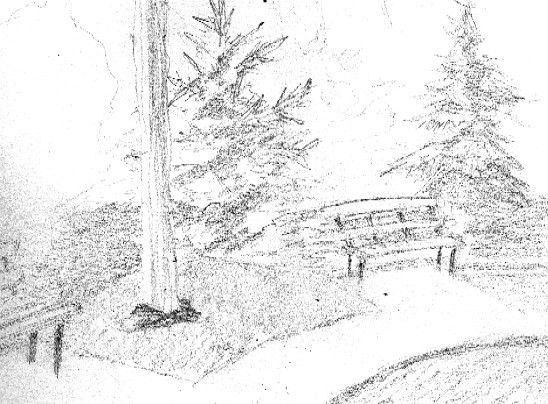 My scanner muddies this up a bit, but you get the idea. And here's the actual picture:  When I draw from a photo, it's much easier to "measure," or compare distances. But it's much tougher when viewing it live. You can see how I skewed the bench, in particular the bench on the right. Where did those curves come from? Trees give me fits. So much texture and complex shading... how do you do that with a pencil in a sketch and make it look real? More good practice. So today, Cub and I went back to the playground. After playing for a while, I went back to the bench and started to sketch this tree:  And here was what I did: 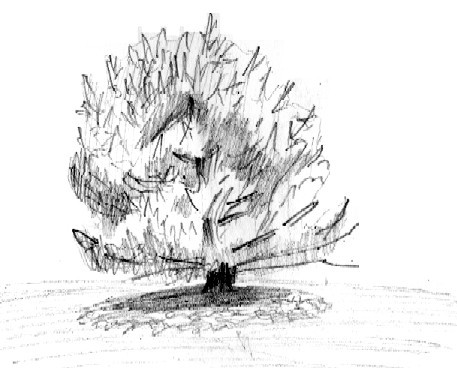 I'm not happy with it, but again, it's all good practice. For what it's worth, if you enjoyed the bike ride video last week, here's another one, which is a short ride through my apartment complex. I came home from my little bike ride and found my son and his girlfriend playing their new favorite game together, Boggle. They had this layout: 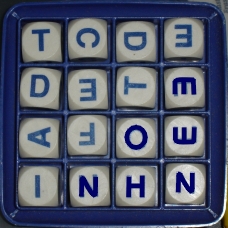 Boggle is a great game. The key to big points is how you look for suffixes and prefixes that lead to larger words. They're learning this, but with this layout, they only managed a few 5-letter words and the rest were smaller. New to the game, they couldn't see these two 6-letter words: 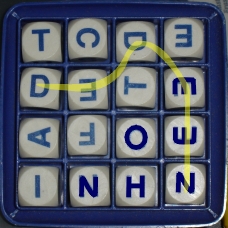 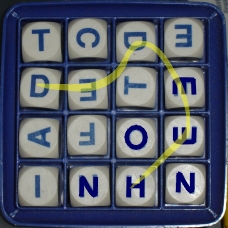 The more I think about it, the more it seems to me that how we see things is the key to success, whether it be painting or management or Boggle - whatever. The techniques, once known to us, don't really require great skill of any kind that we don't already have, but simply practice in how to see things in a way that helps us to our goal. It's a good Sunday... |
|
|
Take a look at the following image:  Could you draw that? I suspect that just about anyone could draw a line that looked reasonably similar to it. How about this one?  A little more difficult, but I still believe that almost anyone could come very close to drawing lines that looked like these. Now here's the thing - these are taken from a larger picture that I've broken up into squares. This is the entire composite: 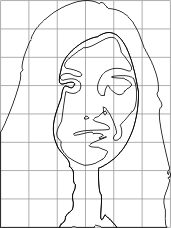 If I removed the grid, it might seem harder to you to freehand draw it. But broken into a grid, it appears much easier. In fact, I suspect that if I left the grid in place, most people would see their way to a step-by-step, or should I say square-by-square, approach to draw this woman. If I had started by asking you to draw the woman shown below, and you didn't believe that you had any skill in drawing, you might have balked.  But if you know of a method that allows you to get there, line by line and step by step, you could then believe it. Here she is "painted," or colored in from the wireframe squares image shown above.  If you had painted such a picture of her, how would you feel about your talent? Painting isn't about talent. It's about knowing the process and then doing it. It's my opinion that anyone can draw and/or paint. Those who wish they could but don't think that they can just need to know how. |
|
|
I bought Richard Schmid's book, "Alla Prima." Easily the best book on the making of art that I've read. Conversational in its tone and deep in its treatment of art, truly a treasure from a man who loves making art. I want to quote his discussion of drawing. It's everything that I would want to say, but he says it far better and with more authority. Emphasis in bold is mine... Enjoy :) There is a popular notion that artists are born with an ability to draw, but that isn't true. The impulse to draw is there, but no one arrives in this world endowed with the capacity to graphically depict visual reality. I have never known a painter who was just "naturally" good at it and could do it without serious training. Drawing is a skill that must be learned, but it isn't like swimming or riding a bike. Once you get the knack of it, you can't relax and just let it happen by itself. It takes constant practice and presence of mind. Why? Because it is not a physical skill; it is a mental discipline. It deals with continual variables rather than the repetition of memorized shapes. I always have the fond hope that someday it will get easier, but it never does. Sound drawing always demands great care right down to the last dab of paint.For most of us, the word "drawing" brings to mind an outline of something. This deeply ingrained assumption originates in childhood when we learned to use lines to make pictures. Yet in real life there are no lines around things. Line drawing is only a representation or diagram of our visual world. Painting, on the other hand (the kind I am dealing with here), attempts to create an illusion of that world. Consequently, in this discussion when I use the word "drawing," I mean the size, shape, and arrangement of all the patches of colors that collectively make things look the way they do (and which also constitutes a painting). When you render those patches the right size, the right shape, and with their distinctive edges and color, your painting will look like your subject. If you don't - it won't. It will look different. Drawing is simply measuring. As it applies to direct painting from life, drawing comes down to nothing more than figuring out the width and height of color shapes and then fitting them together. Still, drawing remains very difficult for nearly everyone, which is odd when you think about it because drawing is only the visual element we work with that seems to deal with a measurable and definable aspect of the visual world. The other three elements: color, value, and edges, are relative qualities with generous room for interpretation. Drawing is about specific dimensions. That, folks, is a masterful explanation of drawing. And if you like painting, or want to paint, buy the book. It's cheaper and available in soft copy at his web site, which is where I bought it. |
|
|
|
|
|
|
|